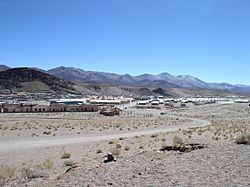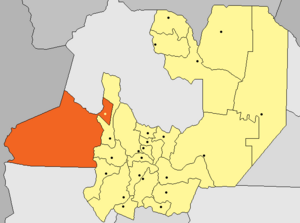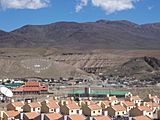San Antonio de los Cobres facts for kids
Quick facts for kids
San Antonio de los Cobres
|
|
|---|---|

A panoramic view of the town, as seen from
the Tren de las Nubes train station |
|

San Antonio (yellow dot) within Los Andes Department (red) and Salta Province
|
|
| Country | |
| Province | |
| Department | |
| Established | ? |
| Elevation | 3,775 m (12,385 ft) |
| Population
(2001)
|
|
| • Total | 5,482 |
| Time zone | UTC−3 (ART) |
| Postal code |
A4411
|
| Climate | BWk |
San Antonio de los Cobres is a small, interesting town in northwestern Argentina. About 5,482 people lived there in 2001. It's the main town of the Los Andes Department in the Salta Province.
Contents
Where is San Antonio de los Cobres?
This town is famous for being very high up. It sits about 3,775 meters (12,385 feet) above sea level. This makes it one of the highest towns in all of Argentina!
San Antonio de los Cobres is about 160 kilometers (99 mi) from the city of Salta. It's also about 2,000 kilometers (1,200 mi) from Argentina's capital, Buenos Aires. The area is part of the Andes desert. It's a dry place with few trees and not much drinking water.
History of the Town
San Antonio de los Cobres was started a long time ago, in 1641. It began as a small place to help with mining in the area. Over time, it grew into an important town in the high Andes mountains. The town's past is closely connected to its mining history. It also has strong ties to the local Indigenous cultures.
Scientists have found something amazing about the people here. They have a special change in their genes. This helps them deal with high levels of arsenic in the area. Arsenic is a natural element that can be harmful. In this region, the water has much more arsenic than is considered safe.
But because people have lived here for so long, their bodies have adapted. They developed a special gene change. This helps them process arsenic faster. It also stops harmful substances from forming in their bodies. This is the first time scientists have seen humans adapt to a toxic chemical in this way!
What is the Economy Like?
The town's name, San Antonio de los Cobres, comes from the nearby Sierra de Cobre. This means "Copper Mountain" in Spanish. The mountain is full of copper.
The town's main jobs come from mining these mineral-rich mountains. People also make things by weaving with local llama wool.
San Antonio de los Cobres is also a stop for the Tren a las Nubes. This means "Train of the Clouds." It's a famous train that travels along the Salta-Antofagasta rail line.
Climate and Weather
San Antonio de los Cobres has a cool, dry climate. It has mild summers and very cold, dry winters. The temperature can change a lot between day and night. This is because of the town's very high altitude.
It hardly ever rains here, except from January to March. During these months, about 96 millimetres (3.78 in) of the yearly 104 millimetres (4.09 in) of rain falls from thunderstorms.
| Climate data for San Antonio de los Cobres | |||||||||||||
|---|---|---|---|---|---|---|---|---|---|---|---|---|---|
| Month | Jan | Feb | Mar | Apr | May | Jun | Jul | Aug | Sep | Oct | Nov | Dec | Year |
| Record high °C (°F) | 25.4 (77.7) |
25.0 (77.0) |
25.0 (77.0) |
21.2 (70.2) |
24.5 (76.1) |
18.0 (64.4) |
17.3 (63.1) |
18.3 (64.9) |
20.0 (68.0) |
23.5 (74.3) |
23.2 (73.8) |
27.0 (80.6) |
27.0 (80.6) |
| Mean daily maximum °C (°F) | 20.4 (68.7) |
20.4 (68.7) |
18.8 (65.8) |
17.9 (64.2) |
13.8 (56.8) |
11.6 (52.9) |
11.9 (53.4) |
12.1 (53.8) |
13.6 (56.5) |
17.3 (63.1) |
18.4 (65.1) |
21.0 (69.8) |
16.4 (61.5) |
| Daily mean °C (°F) | 12.7 (54.9) |
12.5 (54.5) |
11.2 (52.2) |
9.6 (49.3) |
5.9 (42.6) |
3.5 (38.3) |
2.2 (36.0) |
3.2 (37.8) |
7.0 (44.6) |
10.6 (51.1) |
12.3 (54.1) |
12.4 (54.3) |
8.6 (47.5) |
| Mean daily minimum °C (°F) | 4.2 (39.6) |
2.9 (37.2) |
1.4 (34.5) |
−2.9 (26.8) |
−5.7 (21.7) |
−7.0 (19.4) |
−7.7 (18.1) |
−6.7 (19.9) |
−4.6 (23.7) |
−1.0 (30.2) |
0.5 (32.9) |
1.8 (35.2) |
−2.1 (28.2) |
| Record low °C (°F) | −0.3 (31.5) |
−2.0 (28.4) |
−4.8 (23.4) |
−8.5 (16.7) |
−13.2 (8.2) |
−14.5 (5.9) |
−16.0 (3.2) |
−13.0 (8.6) |
−13.8 (7.2) |
−9.2 (15.4) |
−7.5 (18.5) |
−3.5 (25.7) |
−16.0 (3.2) |
| Average precipitation mm (inches) | 44.0 (1.73) |
32.7 (1.29) |
19.4 (0.76) |
0.4 (0.02) |
0.2 (0.01) |
0.0 (0.0) |
0.0 (0.0) |
1.5 (0.06) |
0.6 (0.02) |
0.0 (0.0) |
1.1 (0.04) |
4.0 (0.16) |
103.9 (4.09) |
| Average relative humidity (%) | 54 | 49 | 44 | 36 | 42 | 44 | 58 | 44 | 36 | 34 | 37 | 47 | 43.8 |
| Source: Secretaria de Mineria | |||||||||||||
Gallery
See also
 In Spanish: San Antonio de los Cobres para niños
In Spanish: San Antonio de los Cobres para niños




